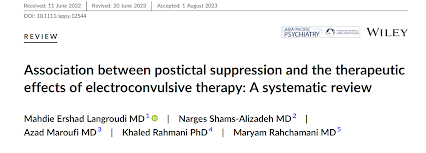Systematic Review of Postictal Suppression in ECT From Iran
Out on PubMed, from authors in Iran, is this review:
Association between postictal suppression and the therapeutic effects of electroconvulsive therapy: A systematic review.
Asia Pac Psychiatry. 2023 Aug 16:e12544. doi: 10.1111/appy.12544. Online ahead of print.PMID: 37587610 Review
The abstract is copied below:
Electroconvulsive therapy (ECT) is an effective and safe medical treatment for patients with severe mood and neuropsychiatric disorders. Since the advent of ECT, extensive research has been performed to identify the predictive factors for response to ECT. In recent decades, postictal suppression on an electroencephalogram (EEG) has been considered a potential predictor of response to ECT. We aimed to investigate the direct association between postictal suppression and the therapeutic effects of ECT. In this systematic review, all articles in the field of the association between postictal suppression and the therapeutic effects of ECT published between 1990 and 2021 were identified. The full texts of these articles, which include clinical trials and retrospective and cross-sectional studies, are available in scholarly research databases and search engines, including PubMed, Google Scholar, OVID, Web of Science, and Scopus. Of all retrieved articles, eight studies, including four retrospective cohort articles and four clinical trials, met the inclusion criteria for further analyses. The findings of this study showed a significant association between postictal suppression and the therapeutic efficacy of ECT. Factors such as electrode placement, tachycardia, type of anesthetic agent, and EEG amplitude were also directly related to postictal suppression and the efficacy of ECT. Postictal suppression on EEG can be considered a predictor of response to ECT. To increase the effectiveness of treatment with ECT and increase postictal suppression, factors including electrode placement, tachycardia, type of anesthesia, and EEG amplitude should be considered, which highlights the need for further research.
Keywords: bipolar disorder; depressive disorder; electroconvulsive therapy; electroencephalogram; postictal suppression; psychotic disorder.
The article is here.
And from the text:
This review, despite its multiple shortcomings, is about an interesting topic. Seizure adequacy has consumed lots of oxygen in our field over the decades. Postictal suppression is one of the strongest indicators of a good seizure, but the literature is much smaller than it could be. Think of all the Thymatron treatments done over the years and the vast amount of clinical data in charts everywhere, even after discounting poor EEG acquisition technique. It is good to be reminded of this parameter, even if the review itself is more like a "least reviewable unit"...




Comments
Post a Comment